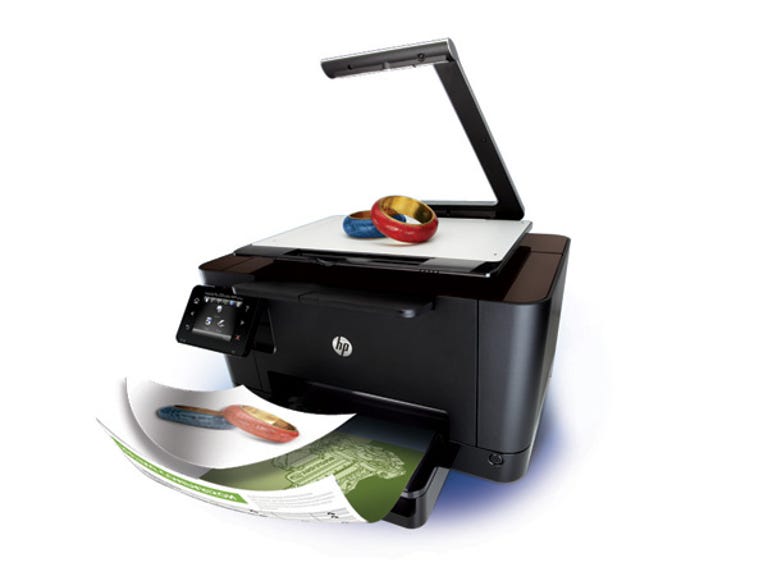 Why You Can Trust CNET
Why You Can Trust CNET HP TopShot LaserJet Pro M275 review: HP TopShot LaserJet Pro M275
HP's 3D-capable MFC has a unique gimmick, but it's one that will only appeal to a tiny niche of users.
Most laser printers tend to look depressingly similar. Grab a white (or off-grey) plastic box, chuck in your choice of inkjet or laser/LED innards, drop a CIS scanner on the top and charge a couple of hundred bucks for it, while waiting for the real money — in toner and ink — to come rolling in.
The Good
The Bad
The Bottom Line
HP's often guilty of that, but not with the TopShot LaserJet Pro M275, which looks like the unholy hybrid of an inkjet printer and an old-school overhead projector, thanks to the exposed scanning tray — which in this case really is a tray that lifts off the main printer body — and the scanning arm that sits well above the main printer itself.
That's due to the TopShot LaserJet Pro M275's main selling gimmick, which is that it's not a traditional scanner, but instead a "3D" scanner — although that's a claim that deserves a little further explanation. Where most scanners run a flat CIS scan head over flat objects, the LaserJet Pro M275 instead uses an 8-megapixel camera head suspended over the scanning plate. In other words, this isn't scanning. It is, quite literally, photocopying. It's also worth noting that this isn't the kind of 3D scanner that you could use to build up libraries of 3D objects for actual 3D printing; what it's intended to do instead is simplify the process of photographing 3D objects for things like business brochures, and, presumably, eBay sales.
Performance
Funky scan/photo heads aside, HP rates the LaserJet Pro M275 as being capable of up to 17 pages per minute in monochrome, and four pages per minute in colour. It's both Apple AirPrint and HP ePrint enabled, and it supports HP's range of printing apps via the 3.5-inch LCD touchscreen on the front of the printer body. For those still stuck in a previous century, you'll be disappointed to note that there's no faxing capability built in. At 468x409x270mm and 13.5kg, it's suitable for dropping (carefully) down onto a desk, something that can't be said of every SOHO colour, multifunction laser printer. You could locate it more remotely, however; aside from USB, it also supports Ethernet and Wi-Fi connectivity.
Most printer speed claims are qualified with "up to", because they're usually terrible exaggerations, but HP has actually been moderately honest with the LaserJet Pro M275, which managed a healthy 13 pages per minute in our standard monochrome laser print-speed tests, with the first page dropping out in a swift 16.5 seconds over an Ethernet connection.
The caveat to this is that the LaserJet Pro M275's normal coverage is a little lighter than you might expect from a laser printer; while it's still decent-quality printing that should pass all but the more critical eye, it's definitely not putting down as much toner as competing models are, leading to slightly grey text. Colour definition was likewise a little on the light side. Lasers aren't typically the best for photo reproduction, but, given the LaserJet Pro M275's particular 3D-scanning capabilities, it would have been nice to see slightly better photo-reproduction capabilities.
The LaserJet Pro M275's big selling point is clearly the 3D-scanning capability. It manages this from the 8MP CMOS sensor in the scan arm, which lifts well above the scan plate. When you choose a 3D scan, it takes three quick flash images, as well as three images using ambient light, and combines them into a 3D JPG, PNG or PDF image, which you can then save or print.

Two examples of the 3D-scanning feature.
(Credit: Alex Kidman/CBSi)
That does have utility, but only for objects of a certain size; while we got some good results with small objects, and could even scan multiple small toys at once, when we moved up to larger things that were closer to the photo head, things got blown out quite quickly. As a test, we scanned a group of small toys, all of which came out reasonably well; but when we moved up to a larger object — in this case, a model of Draco from Dragonheart — the results were much less impressive. It wouldn't be impossible to rescue them with a little light Photoshop massaging in theory, but the purpose of this particular printer is ease of use. If you want crisp sharpness and absolute technical control, you'd still be better off with a dedicated photo studio.
The aforementioned Draco model.
(Credit: Alex Kidman/CBSi)
The other practical upshot of the LaserJet Pro M275's unique design is that while it's capable of scanning regular two-dimensional pieces of paper, it's very slow to do so, and prone to picking up any curl in the paper — which makes scanning magazine pages particularly tricky — and absolutely incapable of anything but manual scanning. If you were using it heavily in a small office with other workers, they'd have to put up with its three-flash pattern for every single page, too.
Overall
The LaserJet Pro M275 is a fairly unique product, but it's also one that targets a very specific niche. If you do need quick and simple 3D product shots — eBay selling remains the most obvious case that we can come up with — it'll do the job to a reasonable but not spectacular level. Beyond that, if you're after colour laser work at this price point, then look elsewhere.


